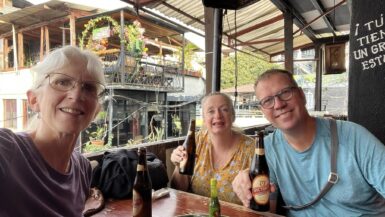Our epic Pacific journey cruised from the intimate lagoons of French Polynesia (Bora Bora, Moorea) across four days of open sea to the volcanic shores of Hawaii (Hilo, Kona, Maui). This post covers our entire Tahiti to Honolulu cruise, highlighting the dramatic contrast between two Pacific paradises.
Following an incredible first leg from Fiji to Tahiti, our grand Pacific voyage continued with an entirely new adventure: the cruise from Papeete, Tahiti, to Honolulu, Hawaii. This 14-day segment wasn't just a change of scenery; it was a journey across one of the world's largest oceans, bridging the intimate beauty of French Polynesia with the iconic, volcanic drama of the Aloha State.
Our journey began in the legendary islands of French Polynesia—Tahiti, Moorea, Raiatea, and the impossibly stunning Bora Bora. Here, the focus was on vibrant turquoise lagoons, lush volcanic peaks, and the warm embrace of Tahitian culture. The vibrant colours and tranquil waters of the South Pacific were unforgettable.
 This cruise also included a deep dive into the Hawaiian Archipelago, where we would trade thatched-roof bungalows for the colossal scale of active volcanoes, black sand beaches, and a distinct, modern island spirit. Stops in Hilo, Kona, and Maui offered a fascinating study in contrast, culminating in the lively bustle of Honolulu. This post covers the entire second chapter of our great cruise adventure—a comprehensive look at the islands, the long, meditative days at sea, and the transition from one Pacific paradise to another.
This cruise also included a deep dive into the Hawaiian Archipelago, where we would trade thatched-roof bungalows for the colossal scale of active volcanoes, black sand beaches, and a distinct, modern island spirit. Stops in Hilo, Kona, and Maui offered a fascinating study in contrast, culminating in the lively bustle of Honolulu. This post covers the entire second chapter of our great cruise adventure—a comprehensive look at the islands, the long, meditative days at sea, and the transition from one Pacific paradise to another.
Tahiti: Setting Out Again
We were a little slow getting going on our second day in Tahiti, but it was nice to have a port where we could just walk into town instead of waiting for a tender boat. We decided to hop on the local bus to explore a bit farther afield, since there were no rental cars available. The people here are so friendly and helpful — even though Tahiti is a bit of a city, it never feels impersonal.  The bus schedule, on the other hand, was more of a suggestion than a plan, running only until mid-afternoon, which made for a shortened day. But we managed to reach a nearby town with a beautiful black sand beach — a place that, according to legend, Columbus once visited (though he seemed to have been everywhere).
The bus schedule, on the other hand, was more of a suggestion than a plan, running only until mid-afternoon, which made for a shortened day. But we managed to reach a nearby town with a beautiful black sand beach — a place that, according to legend, Columbus once visited (though he seemed to have been everywhere). Nicola snorkelled while I stayed on shore, ready to keep an eye out in case the current swept her off. She came back with a story: what she thought was a bit of plastic in the sand turned out to be a beautiful piece of coral, freshly broken and still glowing with colour. We lingered by the pink-painted church nearby and watched a mango drop from a massive tree beside the bus stop — just another small moment that made the day feel perfectly local. By evening, we were back on the ship, watching the sun set over the harbour and feeling ready to begin the next chapter.
Nicola snorkelled while I stayed on shore, ready to keep an eye out in case the current swept her off. She came back with a story: what she thought was a bit of plastic in the sand turned out to be a beautiful piece of coral, freshly broken and still glowing with colour. We lingered by the pink-painted church nearby and watched a mango drop from a massive tree beside the bus stop — just another small moment that made the day feel perfectly local. By evening, we were back on the ship, watching the sun set over the harbour and feeling ready to begin the next chapter.
Moorea Revisited
Our first stop on the new leg was Moorea, and we couldn’t have been happier. It quickly became our favourite island — lush, welcoming, and impossibly beautiful. This time, we rented a car with our friends Jenn and Melissa and toured the entire island. Everywhere we went, the scenery was lush and alive: palm-lined beaches, jagged volcanic peaks, and villages bursting with flowers.  We passed free-roaming chickens and roosters, stopped for tastings at a juice factory (which also served up local spirits), and laughed our way through the afternoon. I found myself sampling raw sugarcane along the roadside, and Nicola took about eight billion photos of the water. The colour here defies description — clear, shifting light on the surface, always different, always spectacular.
We passed free-roaming chickens and roosters, stopped for tastings at a juice factory (which also served up local spirits), and laughed our way through the afternoon. I found myself sampling raw sugarcane along the roadside, and Nicola took about eight billion photos of the water. The colour here defies description — clear, shifting light on the surface, always different, always spectacular.
 Lunch was a splurge — a swordfish burger for Nicola and something equally indulgent for the rest of us. Things are expensive on these islands, but sometimes it’s worth it. After lunch, we swam, wandered, and took in the kind of scenery that makes you wish time could slow down. The day ended with one of those perfect Moorea sunsets that linger just long enough to make you forget everything else. It’s easy to see why people fall in love with this place. We certainly did.
Lunch was a splurge — a swordfish burger for Nicola and something equally indulgent for the rest of us. Things are expensive on these islands, but sometimes it’s worth it. After lunch, we swam, wandered, and took in the kind of scenery that makes you wish time could slow down. The day ended with one of those perfect Moorea sunsets that linger just long enough to make you forget everything else. It’s easy to see why people fall in love with this place. We certainly did.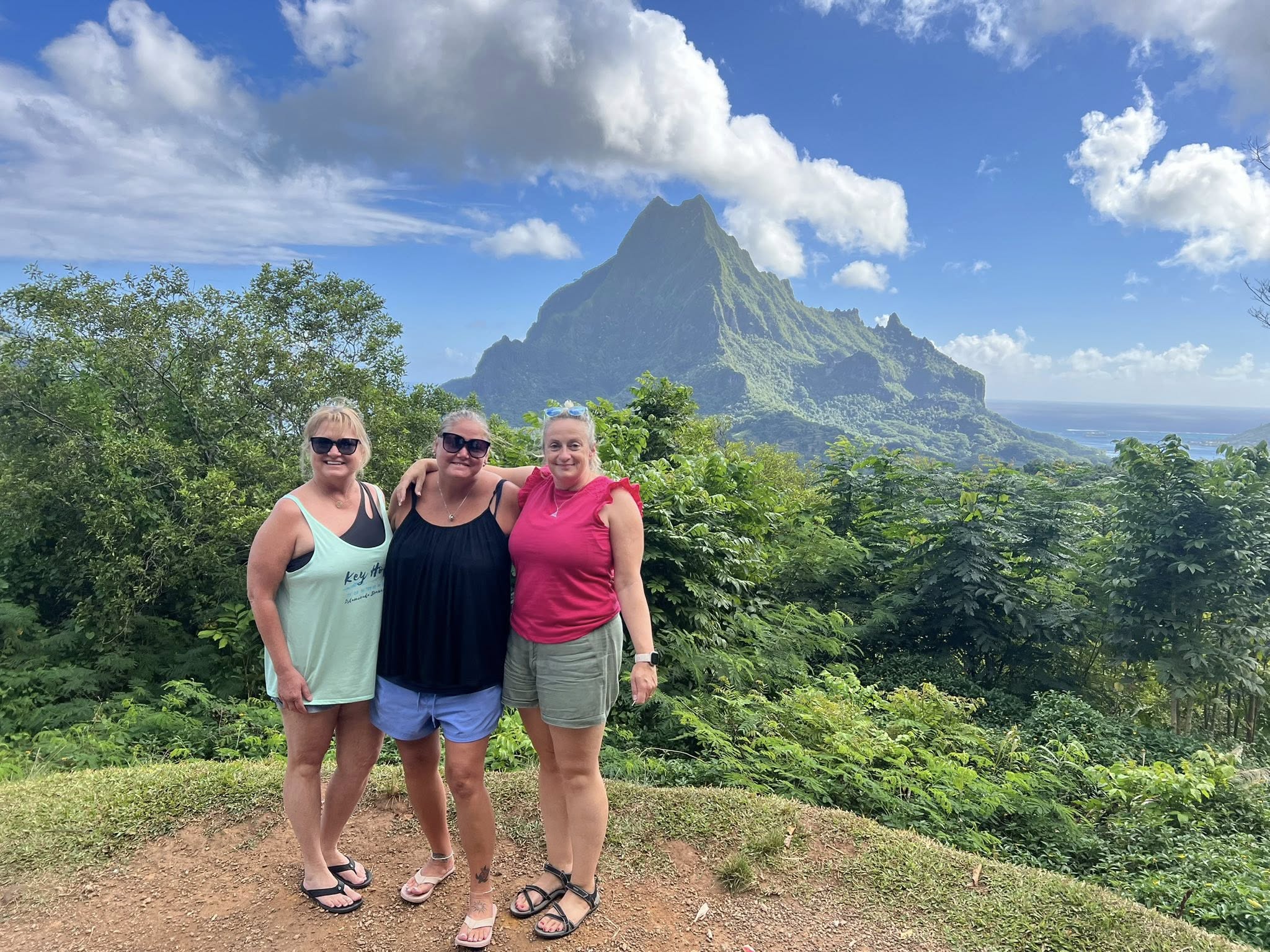

Raiatea: The Heart of Polynesia
Our next stop was Raiatea, and this time we decided to rent a car so we could really see the island. From the moment we stepped ashore, it felt friendly and unhurried — the kind of place where people wave from their front steps and everyone seems to know everyone else.  We stopped at a pearl farm and learned how the famous black pearls are created. The process is surprisingly delicate — inserting a small bead of mother-of-pearl into an oyster, sometimes with a bit of donor tissue to influence colour. As our guide said, “In the end, the oyster decides.” Each one can produce up to three pearls over several years, and he even pointed out the red ropes marking the oysters in their final round. It was fascinating to see how much patience and care go into every pearl.
We stopped at a pearl farm and learned how the famous black pearls are created. The process is surprisingly delicate — inserting a small bead of mother-of-pearl into an oyster, sometimes with a bit of donor tissue to influence colour. As our guide said, “In the end, the oyster decides.” Each one can produce up to three pearls over several years, and he even pointed out the red ropes marking the oysters in their final round. It was fascinating to see how much patience and care go into every pearl.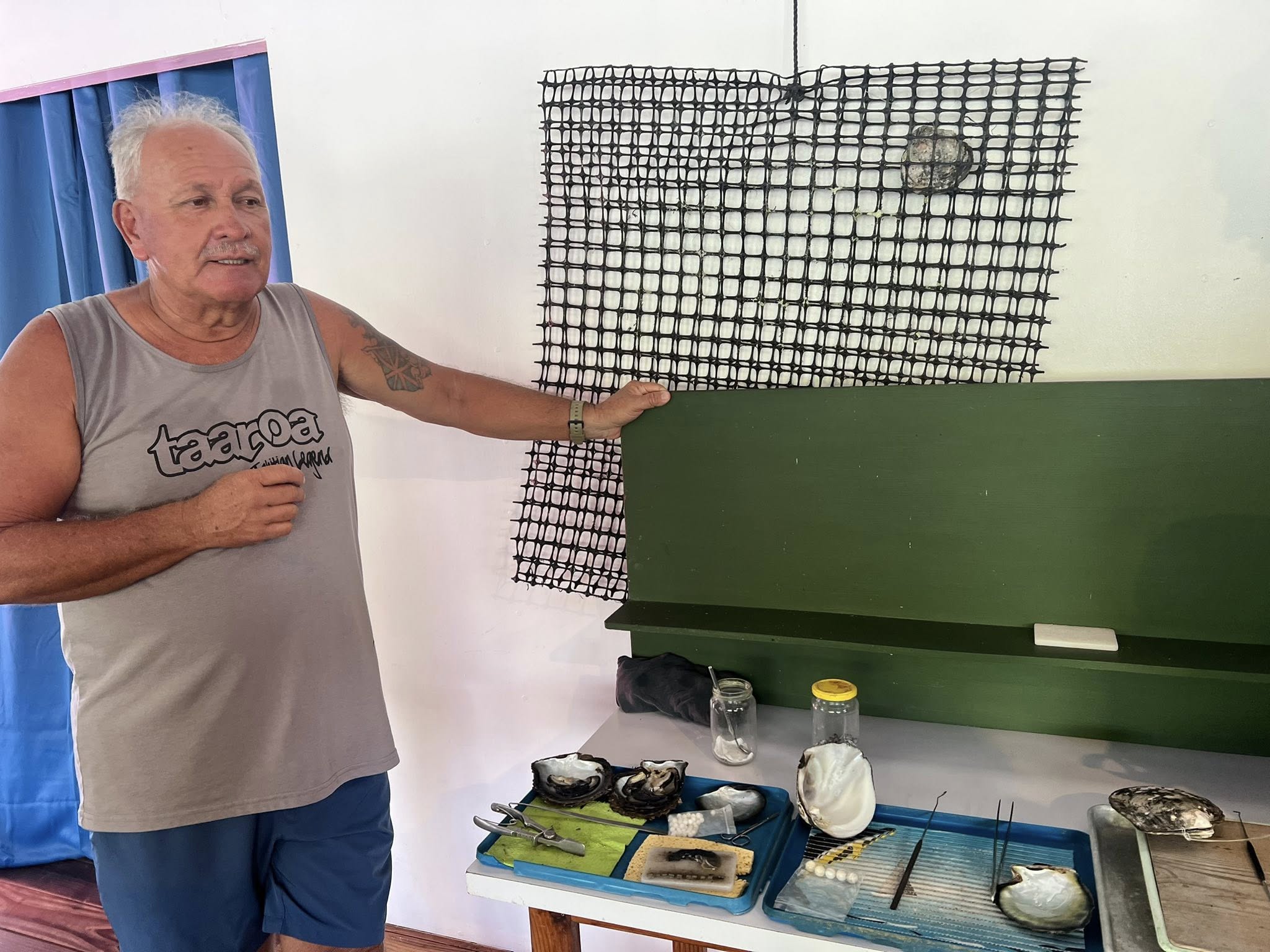

We carried on to a small botanical garden — lush, free, and full of plants we’d never seen before. The island was green and soaked with life, and Nicola joked she wished she could send some of the moisture home. Vanilla farms lined parts of the road, their orchids in full bloom. The scent was wonderful but the prices were sky-high, so we were glad we’d bought some in Madagascar years ago. 
 We stopped for a casual lunch and a cold beer overlooking the beach — just one sip for me since I was driving — before wrapping up the day with a dip in the sea. That evening, we joined friends for dinner at the ship’s teppanyaki restaurant to celebrate Melissa’s birthday, complete with laughter, flying shrimp, and plenty of cheer. It was a perfect end to a perfect island day.
We stopped for a casual lunch and a cold beer overlooking the beach — just one sip for me since I was driving — before wrapping up the day with a dip in the sea. That evening, we joined friends for dinner at the ship’s teppanyaki restaurant to celebrate Melissa’s birthday, complete with laughter, flying shrimp, and plenty of cheer. It was a perfect end to a perfect island day.

Bora Bora, Again and Anew
Our second visit to Bora Bora felt both familiar and brand new. This time, we rented a car and circled the island twice, in opposite directions. It’s small enough that you can drive the whole loop in under an hour, but we stretched it into a full day. The scenery was as stunning as ever: turquoise water, coconut palms heavy with fruit, and hibiscus flowers everywhere you looked.  At one point, we stopped at a small market where locals were dyeing and sun-stencilling sarongs, using traditional designs passed down through families. Even the simplest spots here have beauty — a stray bloom placed beside a cracked sink, a splash of colour where you least expect it.
At one point, we stopped at a small market where locals were dyeing and sun-stencilling sarongs, using traditional designs passed down through families. Even the simplest spots here have beauty — a stray bloom placed beside a cracked sink, a splash of colour where you least expect it. We climbed to a lookout where you could see both sides of the island at once — the kind of view that makes you stop talking altogether. The walk down was steep and slippery, but worth it. We found fields of the national flower —the same one they give you when you arrive —and their scent filled the air. Nicola, true to form, took more flower photos than she’ll ever admit.
We climbed to a lookout where you could see both sides of the island at once — the kind of view that makes you stop talking altogether. The walk down was steep and slippery, but worth it. We found fields of the national flower —the same one they give you when you arrive —and their scent filled the air. Nicola, true to form, took more flower photos than she’ll ever admit.  Along the way, we learned a bit of island history — how American forces used Bora Bora’s lagoon during the war because its surrounding reef made it such a safe harbour. The mayor today is determined to preserve that beauty by limiting large cruise ships, and it shows. The island feels unspoiled, welcoming, and full of warmth.
Along the way, we learned a bit of island history — how American forces used Bora Bora’s lagoon during the war because its surrounding reef made it such a safe harbour. The mayor today is determined to preserve that beauty by limiting large cruise ships, and it shows. The island feels unspoiled, welcoming, and full of warmth. We had two and a half days in Bora Bora this time, enough to explore, swim, and simply soak it all in. One evening, we caught a brilliant sunset over Matira Beach — the kind of moment you wish you could bottle.
We had two and a half days in Bora Bora this time, enough to explore, swim, and simply soak it all in. One evening, we caught a brilliant sunset over Matira Beach — the kind of moment you wish you could bottle.  Later that night, we heard there’d been a small fire at one of the overwater bungalows; thankfully, everyone was safe. The next morning, the calm had returned, and the island looked as peaceful as ever. Bora Bora remains one of those rare places that feels impossible to leave behind.
Later that night, we heard there’d been a small fire at one of the overwater bungalows; thankfully, everyone was safe. The next morning, the calm had returned, and the island looked as peaceful as ever. Bora Bora remains one of those rare places that feels impossible to leave behind.
Days at Sea
After Bora Bora, the ship turned north, and we settled in for four sea days — open ocean, nothing but blue. The rhythm of ship life took over: morning coffee on deck, trivia with Jenn and Melissa in the afternoon, and long dinners in the specialty restaurants at night.  We used our dining passes to make the rounds — Brazilian one evening, French the next, and Italian to finish. Each meal was a small celebration, a reminder that even at sea, there’s plenty to savour.
We used our dining passes to make the rounds — Brazilian one evening, French the next, and Italian to finish. Each meal was a small celebration, a reminder that even at sea, there’s plenty to savour. The days blurred together in the best way — sunrises over endless water, books by the pool, the steady hum of the engines beneath us. At night, the stars came out by the thousands, clearer and closer than we’d ever seen them. There’s something deeply peaceful about being so far from land, carried gently between two worlds. It was the kind of quiet that makes you reflect, the kind that reminds you why you travel in the first place.
The days blurred together in the best way — sunrises over endless water, books by the pool, the steady hum of the engines beneath us. At night, the stars came out by the thousands, clearer and closer than we’d ever seen them. There’s something deeply peaceful about being so far from land, carried gently between two worlds. It was the kind of quiet that makes you reflect, the kind that reminds you why you travel in the first place.
Arrival in Hawaii
After four days at sea, the islands of Hawaii appeared on the horizon — lush, green, and inviting. The quiet rhythm of ship life faded as we prepared for new adventures. It had been a long stretch of ocean between Bora Bora and Hilo, and while the rest was welcome, we were ready to explore again.
Hilo: Volcanoes and Van Troubles
Our arrival in Hilo came with little fanfare, but the excitement of stepping onto Hawaiian soil was enough. Six of us rented a van and headed straight for Volcanoes National Park — or tried to, at least.  The van had no gas, and before we’d even left town, we noticed a strange smell and a sound that didn’t belong. Sure enough, a flat tire. The rental company was quick to respond, swapping us into a new vehicle, and soon we were back on the road, laughing about our unlucky start.
The van had no gas, and before we’d even left town, we noticed a strange smell and a sound that didn’t belong. Sure enough, a flat tire. The rental company was quick to respond, swapping us into a new vehicle, and soon we were back on the road, laughing about our unlucky start.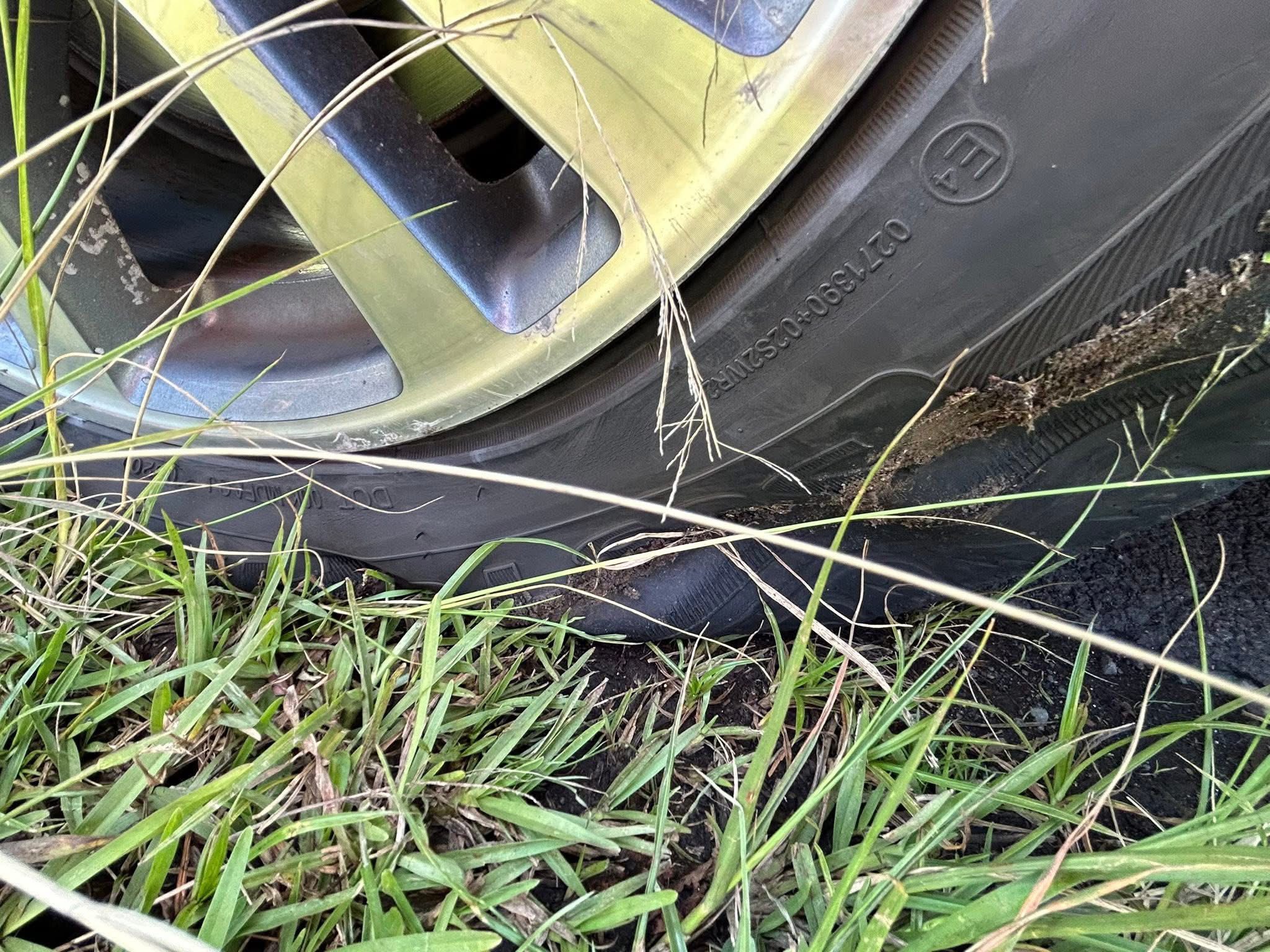 The drive to the park wound through lush ferns, wildflowers, and fields of hardened lava. The volcano had erupted just six days earlier, and the air still carried that sulfur scent. Standing at the crater’s edge, we could see smoke rising faintly from the dark expanse below.
The drive to the park wound through lush ferns, wildflowers, and fields of hardened lava. The volcano had erupted just six days earlier, and the air still carried that sulfur scent. Standing at the crater’s edge, we could see smoke rising faintly from the dark expanse below.  A ranger explained where the lava had flowed, pointing toward the still-warm surface, and shared how thin strands of molten rock — “Pele’s hair” — could drift through the air during eruptions. It was fascinating to imagine the force of nature that had shaped this island.
A ranger explained where the lava had flowed, pointing toward the still-warm surface, and shared how thin strands of molten rock — “Pele’s hair” — could drift through the air during eruptions. It was fascinating to imagine the force of nature that had shaped this island. We stopped for lunch at the Volcano House, overlooking the crater that once erupted mid-meal on Mother’s Day. The views were surreal — steaming vents, blackened rock, and the green resilience of plants already reclaiming the edges.
We stopped for lunch at the Volcano House, overlooking the crater that once erupted mid-meal on Mother’s Day. The views were surreal — steaming vents, blackened rock, and the green resilience of plants already reclaiming the edges.  From there, we followed the road down to the coast, where the lava had carved its way to the sea in waves of frozen motion. The trees that had managed to survive clung to life in cracks of stone. On the way back, we stopped at Rainbow Falls (ironically without a rainbow) and admired the dense, fern-filled landscape that felt like a world reborn from fire.
From there, we followed the road down to the coast, where the lava had carved its way to the sea in waves of frozen motion. The trees that had managed to survive clung to life in cracks of stone. On the way back, we stopped at Rainbow Falls (ironically without a rainbow) and admired the dense, fern-filled landscape that felt like a world reborn from fire.
Kona: Slow Shores and Soft Serve
The next day, we anchored off Kona, where the pace of life felt gentler. We didn’t rent a car this time — just wandered through town, enjoying the shops, small churches, and seaside paths.  Everything seemed to be built from lava rock and coral, a reminder that the island is both fragile and eternal. Nicola was in her element, camera in hand, capturing flowers and massive banyan trees that seemed to swallow entire blocks.
Everything seemed to be built from lava rock and coral, a reminder that the island is both fragile and eternal. Nicola was in her element, camera in hand, capturing flowers and massive banyan trees that seemed to swallow entire blocks. We treated ourselves to Dole pineapple soft serve — sweet, cold, and exactly what you want in Hawaii — and later found a local brewery to sample what they had on tap. Only one was a lager, but it paired perfectly with pizza topped, of course, with pineapple. Ironically, there’s no such thing as “Hawaiian pizza” in Hawaii, but that didn’t stop us from enjoying every bite.
We treated ourselves to Dole pineapple soft serve — sweet, cold, and exactly what you want in Hawaii — and later found a local brewery to sample what they had on tap. Only one was a lager, but it paired perfectly with pizza topped, of course, with pineapple. Ironically, there’s no such thing as “Hawaiian pizza” in Hawaii, but that didn’t stop us from enjoying every bite.
Maui: Turtles and the Road Ahead
Maui greeted us with another understated welcome, though the beauty of the island made up for it instantly. We rented a car — a slightly fancier one this time — and set off to explore. 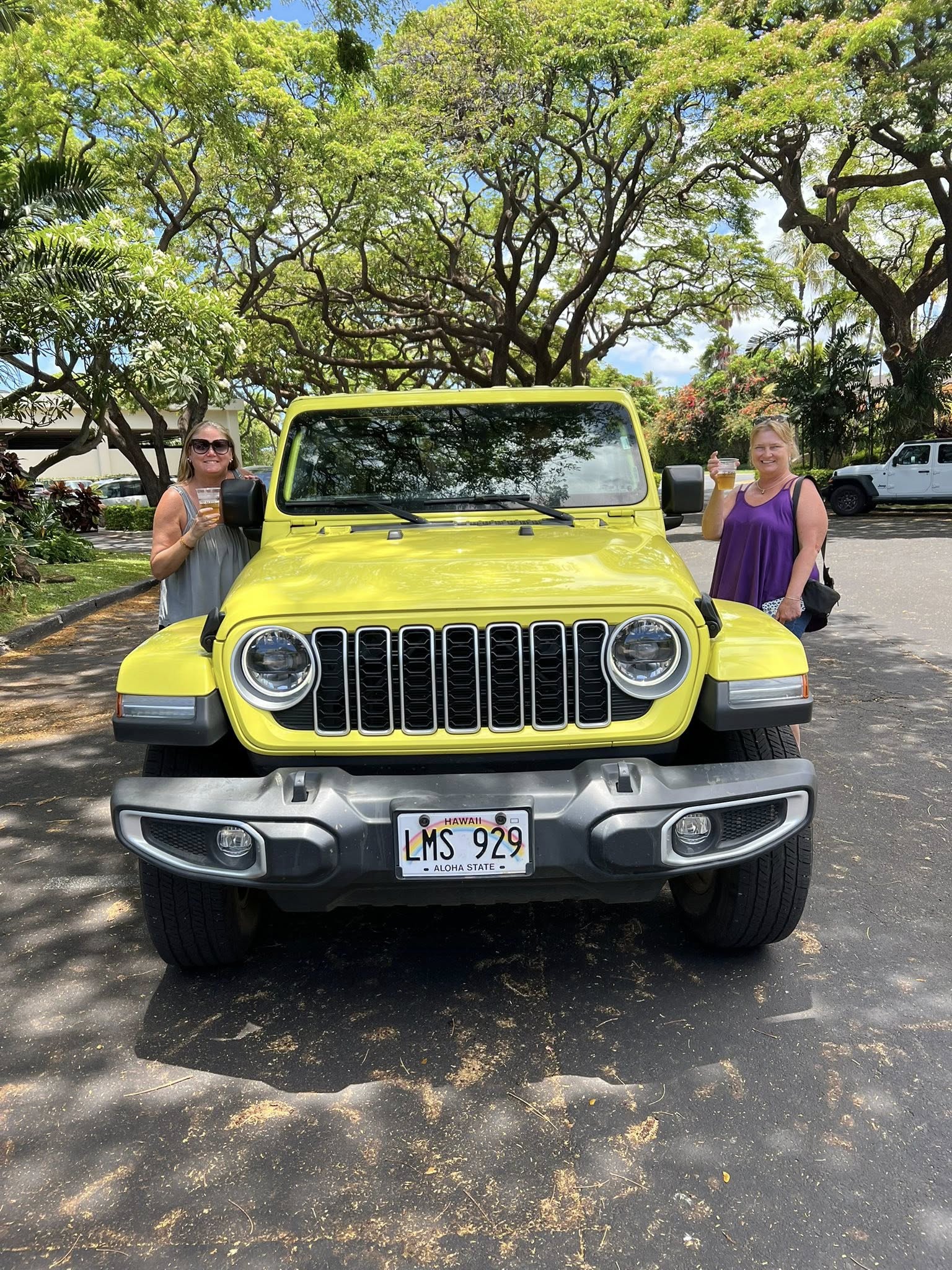 The coastline was rugged and full of life, waves rolling against dark volcanic rock, and sea turtles gliding lazily near the shore. At first, Nicola thought the rocks were just that — until one of them moved. There were dozens of turtles, slow and graceful, making their way through the surf. Watching them felt strangely peaceful, as if time itself had slowed.
The coastline was rugged and full of life, waves rolling against dark volcanic rock, and sea turtles gliding lazily near the shore. At first, Nicola thought the rocks were just that — until one of them moved. There were dozens of turtles, slow and graceful, making their way through the surf. Watching them felt strangely peaceful, as if time itself had slowed.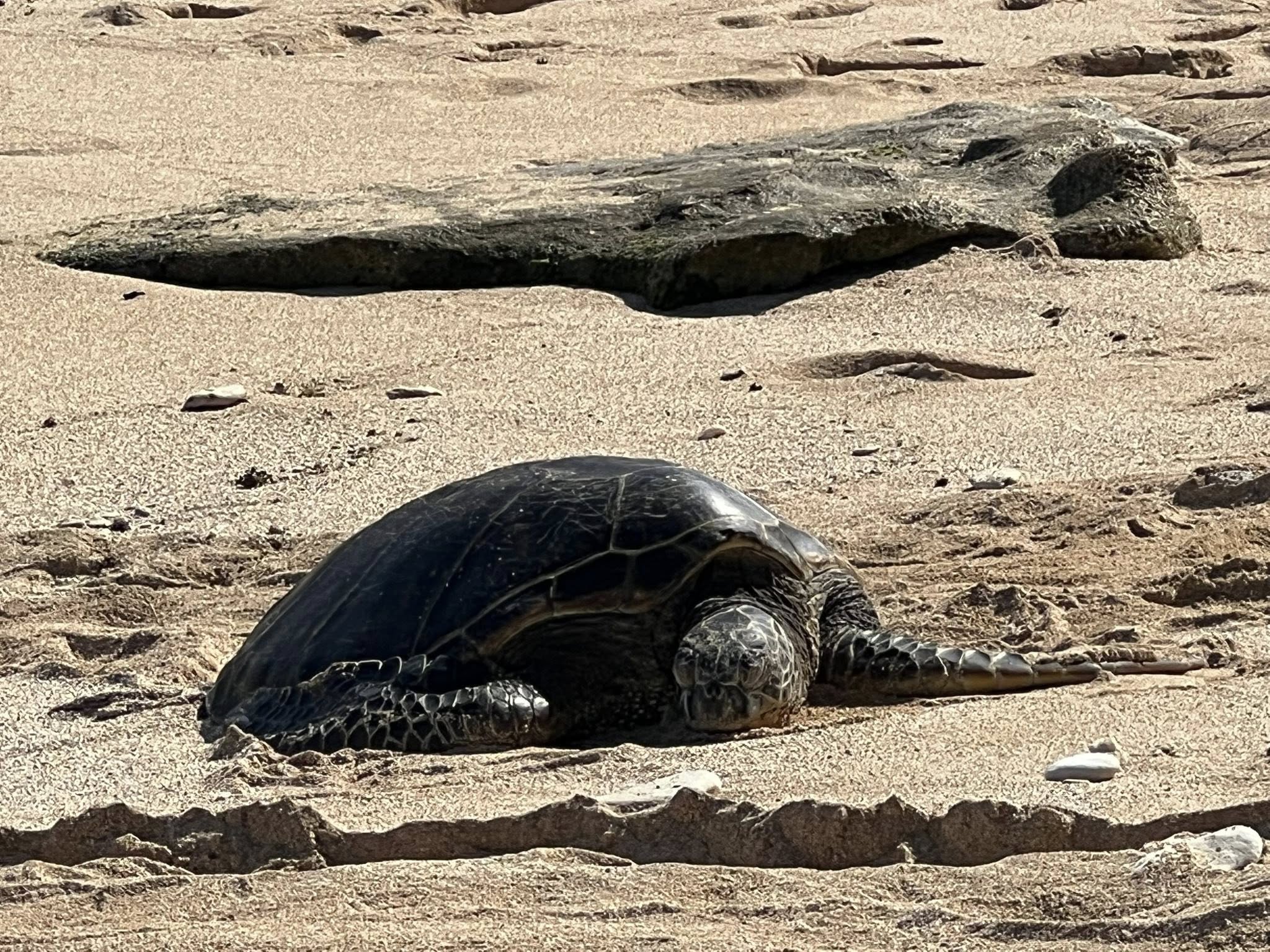 We passed pineapple stands along the roadside and were amused to see they were nearly the same price as back home, just in U.S. dollars. The drive took us along narrow, winding roads with sharp drop-offs and spectacular views.
We passed pineapple stands along the roadside and were amused to see they were nearly the same price as back home, just in U.S. dollars. The drive took us along narrow, winding roads with sharp drop-offs and spectacular views.  In Lahaina, we saw the lingering signs of last year’s fires — areas still under repair, small pockets of rebuilding underway. It was sobering to see the damage up close, but also heartening to see the resilience of the people and the land. We ended the day with a fantastic meal at a Mexican restaurant on board, courtesy of Jenn and Melissa, and toasted to the end of our island hopping.
In Lahaina, we saw the lingering signs of last year’s fires — areas still under repair, small pockets of rebuilding underway. It was sobering to see the damage up close, but also heartening to see the resilience of the people and the land. We ended the day with a fantastic meal at a Mexican restaurant on board, courtesy of Jenn and Melissa, and toasted to the end of our island hopping.

Kauai: Chickens, Coffee, and Lilo & Stitch's Town
Stepping onto the island of Kauai, the "Garden Isle," felt like entering a world separate from the others. We quickly picked up our rental car—the perfect excuse for another road trip with Jenn and Melissa—and set off to explore its distinct western coast. Our first official stop was the charming, historic town of Hanapepe, which fans of Disney will recognize as the inspiration for the town in Lilo & Stitch. Walking its quiet streets, admiring the colourful, rustic buildings, and crossing the famous swinging bridge, it was easy to see how this place captured the magic of island life.  While there, a mandatory photo opportunity presented itself at J. J. Ohana's Gift Shop, where I couldn't resist posing with the gigantic, over-the-top backpack that seems to guard the entrance. Later, we even found ourselves at the most western-most bookstore in the United States, a quirky and memorable stop that perfectly encapsulates the unique charm of this island.
While there, a mandatory photo opportunity presented itself at J. J. Ohana's Gift Shop, where I couldn't resist posing with the gigantic, over-the-top backpack that seems to guard the entrance. Later, we even found ourselves at the most western-most bookstore in the United States, a quirky and memorable stop that perfectly encapsulates the unique charm of this island.
 After soaking up the small-town atmosphere, we headed inland for a completely different kind of natural beauty: the Kalalau Lookout. The drive up was an adventure in itself, but the payoff was breathtaking. Gazing out over the dramatic, plunging cliffs and razor-sharp ridges of the Nā Pali Coast and Waimea Canyon was truly awe-inspiring—a spectacular, grand view that words and photos can barely capture.
After soaking up the small-town atmosphere, we headed inland for a completely different kind of natural beauty: the Kalalau Lookout. The drive up was an adventure in itself, but the payoff was breathtaking. Gazing out over the dramatic, plunging cliffs and razor-sharp ridges of the Nā Pali Coast and Waimea Canyon was truly awe-inspiring—a spectacular, grand view that words and photos can barely capture. 
 To bring us back down to earth, we took a more aromatic and grounded tour at the Kauai Coffee plantation. We enjoyed a fascinating walking tour of the groves, learned about the bean-to-cup process, and ended with a lively sampling session. I tried a half-dozen different roasts, and true to form, Jenn and Melissa found the perfect blends to take home as gifts, ensuring a little piece of Kauai could be enjoyed long after the trip was over.
To bring us back down to earth, we took a more aromatic and grounded tour at the Kauai Coffee plantation. We enjoyed a fascinating walking tour of the groves, learned about the bean-to-cup process, and ended with a lively sampling session. I tried a half-dozen different roasts, and true to form, Jenn and Melissa found the perfect blends to take home as gifts, ensuring a little piece of Kauai could be enjoyed long after the trip was over. One of the most hilarious and constant observations we made across Kauai was the sheer ubiquity of the chickens! They are everywhere—roaming beaches, crossing roads, and generally acting like they own the place. You see signs everywhere advising you not to feed the feral cats or the chickens, but they are absolutely an integrated part of the island experience.
One of the most hilarious and constant observations we made across Kauai was the sheer ubiquity of the chickens! They are everywhere—roaming beaches, crossing roads, and generally acting like they own the place. You see signs everywhere advising you not to feed the feral cats or the chickens, but they are absolutely an integrated part of the island experience.  This reality was driven home spectacularly when we stopped at the local Costco for some uniquely Hawaiian gifts. Right inside the entrance, mingling with shoppers, was a rooster, unbothered and apparently waiting for his membership card to be checked. It was a perfect, funny microcosm of the island's unique atmosphere. Naturally, we grabbed a few great island-themed souvenirs to remember our time here.
This reality was driven home spectacularly when we stopped at the local Costco for some uniquely Hawaiian gifts. Right inside the entrance, mingling with shoppers, was a rooster, unbothered and apparently waiting for his membership card to be checked. It was a perfect, funny microcosm of the island's unique atmosphere. Naturally, we grabbed a few great island-themed souvenirs to remember our time here.
Oahu: Pineapple and Farewell
Our final stop was Oahu — a mix of vibrant city energy and lush countryside. We joined a visit to the Dole Plantation, where we learned how pineapples grow, how to cut them properly, and that you can even plant your own from the crown. The “pink pineapple” was a novelty, as was the price tag, but the Dole whip was as good as ever. The plantation was colourful and lighthearted, a perfect contrast to the bittersweet feeling of knowing our journey was ending.
The “pink pineapple” was a novelty, as was the price tag, but the Dole whip was as good as ever. The plantation was colourful and lighthearted, a perfect contrast to the bittersweet feeling of knowing our journey was ending.
We wandered through a few small shops, admired a chameleon who seemed to pose for photos, and drove past beaches where people were surfing, swimming, and simply living their island life. 

 The open-air airport in Honolulu felt both casual and final — the end of a month at sea. As we waited to board our flight home, I couldn’t help but think how quickly it had all gone by, and how vast the Pacific suddenly seemed again.
The open-air airport in Honolulu felt both casual and final — the end of a month at sea. As we waited to board our flight home, I couldn’t help but think how quickly it had all gone by, and how vast the Pacific suddenly seemed again.
Final Reflection: A Journey of Pacific Contrasts
As the ship pulled into the port of Honolulu, we closed the book on a monumental segment of travel. This journey, from the moment we sailed out of Tahiti through the waters to Hawaii, wasn't just a cruise; it was a masterclass in the sheer scale and dizzying diversity of the Pacific Ocean.
 In one trip, we experienced the tranquil, intimate beauty of the Polynesian islands, where the world felt confined to a perfect lagoon in Bora Bora, and then navigated the dramatic, sprawling landscapes of Hawaii, where mountains touched the clouds and the land felt alive with volcanic energy. The long, rhythmic days at sea connecting these two archipelagos provided the quiet, meditative space necessary to absorb the scale of the world and appreciate the stark contrast between two distinct cultures that share the same vast ocean.
In one trip, we experienced the tranquil, intimate beauty of the Polynesian islands, where the world felt confined to a perfect lagoon in Bora Bora, and then navigated the dramatic, sprawling landscapes of Hawaii, where mountains touched the clouds and the land felt alive with volcanic energy. The long, rhythmic days at sea connecting these two archipelagos provided the quiet, meditative space necessary to absorb the scale of the world and appreciate the stark contrast between two distinct cultures that share the same vast ocean.
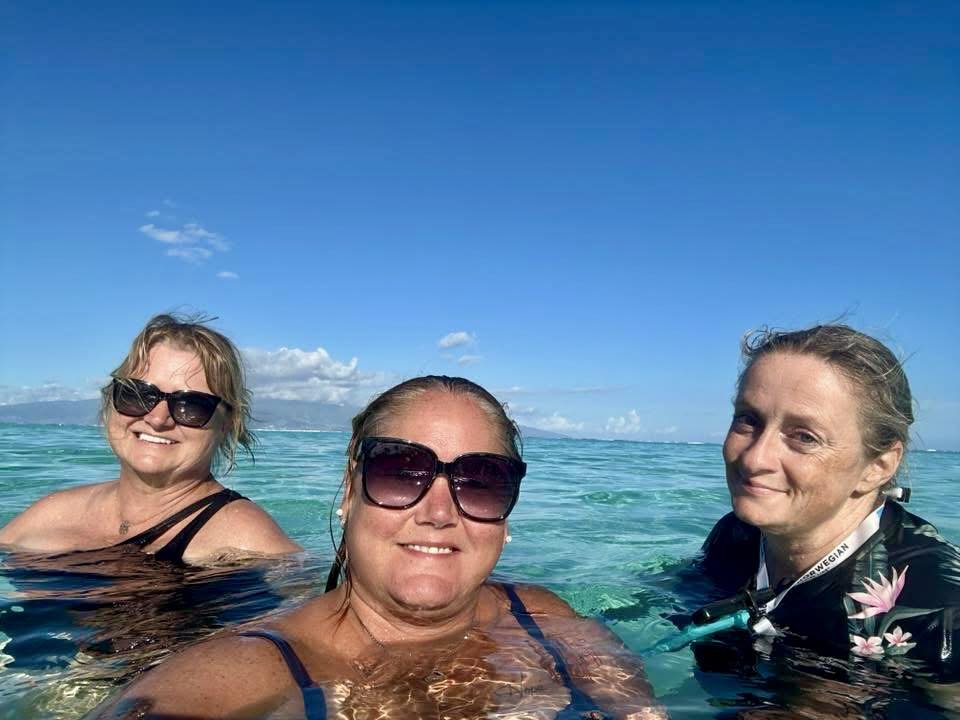 From snorkelling in Moorea's coral gardens to walking the dramatic black lava fields of Kona, the transition was profound. We started in a world defined by the colour blue and ended in a place painted in the reds, greens, and blacks of fire and earth.
From snorkelling in Moorea's coral gardens to walking the dramatic black lava fields of Kona, the transition was profound. We started in a world defined by the colour blue and ended in a place painted in the reds, greens, and blacks of fire and earth.  This segment solidified a new appreciation for the Pacific—not as a single entity, but as a mosaic of unique, breathtaking island worlds. We left Honolulu with sun-kissed skin, a camera full of impossible blue, and a renewed sense of awe for the planet's grandest ocean. The voyage may have ended, but its rhythm stayed with us — calm, steady, and unforgettable.
This segment solidified a new appreciation for the Pacific—not as a single entity, but as a mosaic of unique, breathtaking island worlds. We left Honolulu with sun-kissed skin, a camera full of impossible blue, and a renewed sense of awe for the planet's grandest ocean. The voyage may have ended, but its rhythm stayed with us — calm, steady, and unforgettable.


